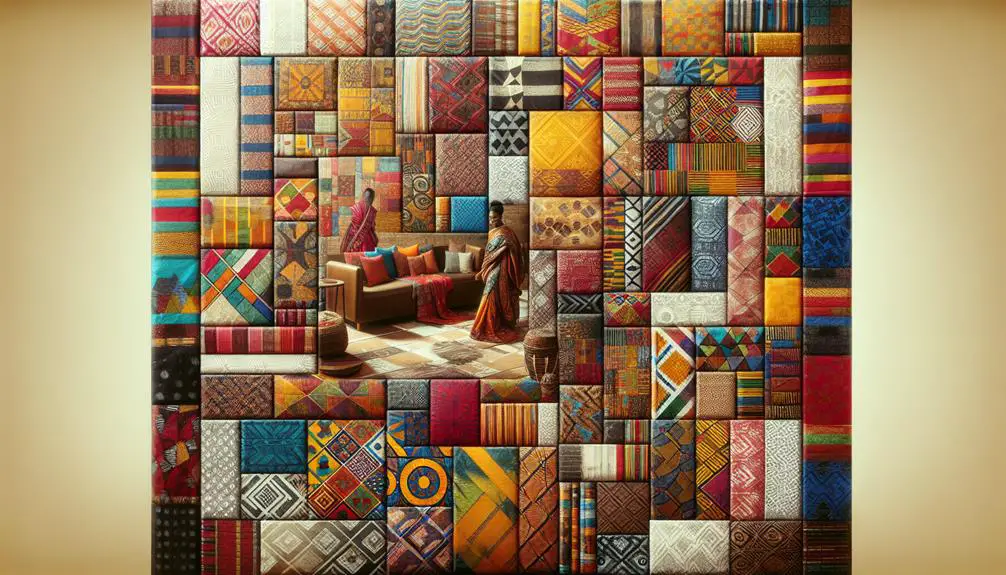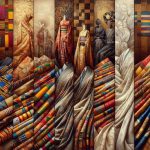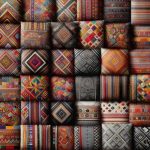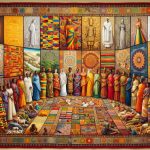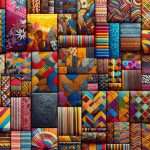Imagine unwrapping the layers of Cleopatra's linen or the vibrant kente cloth of Ghana. You'll find that fabrics aren't just mere materials; they're woven tales of culture and tradition. From the intricate patterns of African textiles to the luxurious sheen of Banarasi Silk in India, each piece tells a unique story. Consider how the elegant folds of a Japanese kimono or the geometric designs in Andean weaving convey more than just aesthetic beauty. What deeper messages and histories are stitched into these cultural fabrics? Let's explore the threads that bind us in such diverse and meaningful ways.
Table of Contents
Key Takeaways
- Fabrics symbolize cultural identity and status, such as Kente cloth in Ghana and Kimonos in Japan.
- Traditional techniques like weaving, dyeing, and embroidery preserve cultural heritage in textiles globally.
- Textiles serve as storytelling tools, depicting historical events, religious narratives, and daily life scenes.
- Natural dyes and intricate patterns in fabrics reflect regional resources and artistic craftsmanship.
- Evolving tapestry designs illustrate societal changes and artistic movements through detailed scenes and innovative techniques.
African Textiles
African textiles are renowned for their vibrant colors, intricate patterns, and cultural significance. They're not just fabrics; they're a narrative of the continent's rich history and diverse cultures.
You'll find that traditional techniques like weaving, dyeing, and embroidery have been passed down through generations, each carrying profound cultural significance. For instance, Kente cloth from Ghana is a symbol of royalty and has intricate patterns that convey messages about the wearer's status and history.
But it's not all about tradition. African textiles have evolved, merging traditional techniques with contemporary designs that capture global attention. Designers are taking these age-old methods and infusing them with modern aesthetics, creating pieces that resonate worldwide.
You've probably seen these textiles influencing global fashion runways and home decor, showcasing their versatility and timeless appeal. The global influence of African textiles is undeniable; they're now a staple in the fashion industry, embraced by designers and consumers alike.
Indian Fabrics
Just like African textiles, Indian fabrics are steeped in history and cultural significance, showcasing a rich tapestry of tradition and innovation. When you explore Indian fabrics, you're immersing yourself in an art form that's as ancient as it is diverse. The way a sari is draped can differ dramatically from one region to another, each style reflecting local customs and aesthetics.
Block printing is another hallmark of Indian textiles. This age-old technique involves carving intricate designs into wooden blocks, dipping them in dye, and pressing them onto fabric. The result is a stunning array of patterns that bring stories and heritage to life with every print.
| Fabric Type | Key Characteristics |
|---|---|
| Banarasi Silk | Luxurious, intricate designs |
| Chanderi | Lightweight, shimmering appearance |
| Kalamkari | Hand-painted, vivid motifs |
Japanese Kimono
The Japanese kimono, a symbol of elegance and tradition, has captivated the world with its intricate designs and cultural significance. When you explore the world of kimono craftsmanship, you'll uncover a rich history that reflects the artistry and meticulous skill passed down through generations. Each stitch and fabric choice speaks volumes about Japan's cultural heritage.
But it's not just about tradition. Modern influences have breathed new life into kimono design, making them relevant in today's fashion landscape. Here's what you should know:
- Traditional Craftsmanship: Artisans dedicate years to mastering the techniques needed to create a kimono, from selecting the perfect silk to hand-painting intricate patterns.
- Cultural Significance: Kimonos aren't just clothing; they embody social status, marital status, and even seasonal changes, making them deeply significant in Japanese culture.
- Modern Influences: Contemporary designers are blending traditional elements with modern aesthetics, creating pieces that appeal to both young and old.
- Versatile Use: While traditionally worn during important ceremonies, kimonos are now seen on international runways, in street fashion, and even adapted for everyday wear.
Andean Weaving
Rooted in the highlands of South America, Andean weaving showcases a vibrant tapestry of history, culture, and craftsmanship. When you explore this ancient art, you'll discover how each piece tells a story through its intricate patterns and vivid colors. The weavers use natural dyes derived from plants, insects, and minerals, which not only provide a stunning array of hues but also connect the textiles to the rich Andean landscape.
You'll be amazed by the geometric designs that characterize Andean weavings. These patterns aren't just decorative; they carry deep symbolic meanings and reflect the weavers' connection to their environment and cosmology. Triangles, diamonds, and zigzags are meticulously arranged, representing mountains, rivers, and other elements of Andean life. Mastering these designs requires immense skill and patience, passed down through generations.
As you explore further, you'll appreciate how Andean fabrics embody a blend of tradition and innovation. While ancient techniques are preserved, contemporary weavers also incorporate modern elements, ensuring the craft remains dynamic and relevant.
Middle Eastern Cloth
When you explore Middle Eastern cloth, you'll notice the intricate traditional textile techniques that have been passed down through generations.
The symbolic patterns and vibrant colors tell stories of cultural heritage and regional identity.
Let's uncover how these elements make Middle Eastern fabrics unique and meaningful.
Traditional Textile Techniques
Middle Eastern fabric displays intricate weaving methods that have been passed down through generations. You'll be amazed by the meticulous stitching techniques and the vibrant coloring methods that create these stunning textiles. These traditional methods aren't just about aesthetics; they reflect the rich cultural heritage and craftsmanship of the region.
To deepen your understanding of these remarkable traditions, consider the following:
- Stitching Techniques: Middle Eastern stitching is renowned for its precision and beauty. You'll find styles like the Palestinian Tatreez or Bedouin motifs, each telling unique stories through stitches.
- Coloring Methods: Natural dyes derived from plants, minerals, and insects are used to achieve the vivid colors. Techniques like the Turkish indigo coloring process have been perfected over centuries.
- Weaving Patterns: Handloom weaving is a labor-intensive process that produces exquisite fabrics like Persian carpets or Egyptian khayamiya. These items aren't just functional but also artistic masterpieces.
- Fabric Choices: From silk to wool, the choice of material plays an essential role. You'll notice that materials are selected not just for their texture but also for their symbolism and utility.
Mastering these techniques offers you a window into the soul of Middle Eastern culture. Immerse yourself and explore the legacy preserved in each thread and dye.
Symbolic Patterns & Colors
As you explore the intricate artistry of Middle Eastern textile techniques, you'll find that symbolic patterns and colors play an essential role in conveying cultural narratives and values. Each thread and hue is carefully chosen, reflecting a rich tapestry of heritage and tradition.
The cultural significance of these textiles goes beyond mere aesthetics; they're a means of storytelling, preserving history, and expressing identity.
Patterns such as geometric shapes, floral motifs, and intricate arabesques aren't just decorative elements. They embody layers of meaning, often rooted in religious and social symbolism. For instance, the use of intricate geometric patterns can signify the infinite nature of Allah in Islamic art, while floral designs may represent paradise and divine beauty.
Colors, too, are imbued with meaning. Deep reds often symbolize power and wealth, while greens are associated with fertility and life, stemming from their prominence in Islamic culture. Blues can represent protection and spirituality, a nod to the region's historical trade in lapis lazuli.
Mastering the traditional craftsmanship behind these textiles isn't merely about technique; it's about understanding the profound narratives woven into each piece, making every fabric a living reflection of Middle Eastern cultural heritage.
European Tapestry
European tapestry, with its intricate designs and rich history, showcases the region's artistic and cultural evolution. When you explore the historical significance and artistic craftsmanship of European tapestries, you'll find that they were more than just decorative pieces. They were symbols of power, wealth, and religious devotion.
The cultural representation and design evolution in these tapestries reveal a lot about European societies through the ages. From medieval religious scenes to Renaissance depictions of mythology, each tapestry tells a story, reflecting the values and aspirations of the time.
To deepen your understanding, consider the following key points:
- Historical Significance: Tapestries were used to insulate and adorn the cold, stone walls of castles and churches, illustrating their importance in daily life.
- Artistic Craftsmanship: The process of creating a tapestry involved skilled artisans working for months, even years, to complete a single piece.
- Cultural Representation: Tapestries often depicted historical events, religious narratives, and scenes from daily life, offering a window into the past.
- Design Evolution: Over centuries, tapestry designs evolved from simple geometric patterns to complex scenes with detailed human figures and landscapes.
Frequently Asked Questions
What Are the Environmental Impacts of Fabric Production?
Think of fabric production's environmental impact like a ripple effect. You can lower the carbon footprint with sustainable practices and recycling. Embrace eco-friendly initiatives to guarantee you're part of the solution, not the pollution.
How Do Traditional Fabrics Influence Modern Fashion Trends?
You see traditional influences in modern trends through the use of classic patterns, techniques, and materials. Designers often blend heritage aesthetics with contemporary styles, creating unique, timeless pieces that resonate with both cultural appreciation and current fashion sensibilities.
What Technological Advancements Are Shaping the Future of Textiles?
You might worry that technology can't truly transform textiles, but smart textiles and sustainable innovations are revolutionizing the industry. These advancements not only enhance functionality but also prioritize eco-friendly practices, catering to a future-focused audience.
How Are Synthetic Fabrics Different From Natural Ones?
Synthetic fabrics differ from natural ones in key ways. They often offer greater fabric durability and sustainability. However, natural fabrics usually excel in comfort and breathability, making them preferable for everyday wear.
What Are the Ethical Concerns in the Global Textile Industry?
You reap what you sow. When considering the global textile industry, you must focus on ethical sourcing and fair labor practices. Prioritize transparency and sustainability to guarantee workers' rights and environmental standards are respected.
- How Does Ring Spun Cotton Affect Garment Fit and Shape Retention? - August 13, 2024
- What Are the Challenges in Producing Ring Spun Cotton? - August 13, 2024
- Is Ring Spun Cotton Suitable for Plus-Size Clothing? - August 13, 2024

